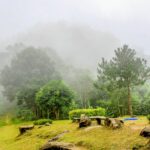On Tuesday, Chiang Mai, the capital of northern Thailand’s Chiang Mai province, topped the list of cities with the world’s dirtiest air due to fine dust.
On the morning of 9 April, Chiang Mai topped the list of cities with the world’s dirtiest air as thick smog continued to linger over Thailand’s northern region.
Chiang Mai regained the title of the city with the dirtiest air at 9:20 am a.m., when fine dust levels were 203 micrograms per cubic metre, according to the IQAir ranking. The air quality monitoring website called the situation in the city ‘very unhealthy,’ and it will continue for a week.
Thailand celebrates the Songkran water festival from Thursday until the following Monday and the city of Chiang Mai is usually one of the most popular tourist destinations.
However, on Monday, 8 April, Chiang Mai Governor Nirat Pongsitthaworn declared seven districts in the province a disaster zone, excluding the capital, despite Chiang Mai city being one of the most polluted areas in the province.
The disaster zone status makes it easier to provide emergency aid from the budget to the districts of Fang, Phrao, Chiangdao, Maetaeng, Chaiprakarn, Maeai and Viengkhaeng.
The governor ordered provincial officials to work at home until Thursday due to air pollution. Residents and visitors were advised to refrain from outdoor activities if possible and to wear masks when leaving the house.
At the press conference, the governor was asked why Chiang Mai’s pollution levels and the number of respiratory illnesses patients were deliberately downplayed. The governor denied the allegation. Officials have given the press all the information, and you are free to write about it,’ the governor said.
Chiang Mai regained the title of the city with the dirtiest air at 9:20 am, with acceptable dust levels of 203 micrograms per cubic metre.
Moving Forward Party chief councillor, Pita Limjaroenrat said the governor and provincial officials are selective in addressing the problems. ‘Other areas of the province with serious air pollution have not become disaster areas,’ Pita wrote on Platform X.
The northern provinces of Lamphun, Lampang, Phayaw, Nhan and Mae Hong Son also made the list of regions with high PM2.5 dust levels on Tuesday. However, according to the Pollution Control Department, the situation there is less critical than in Chiang Mai.
Ahead of Songkran, forecasters issued an alert warning of possible summer storms in the northern, northeastern, and central regions until Thursday. The Meteorological Department said scattered storms are expected in Chiang Mai on Wednesday and Thursday.
More Articles Here
More Articles Here










